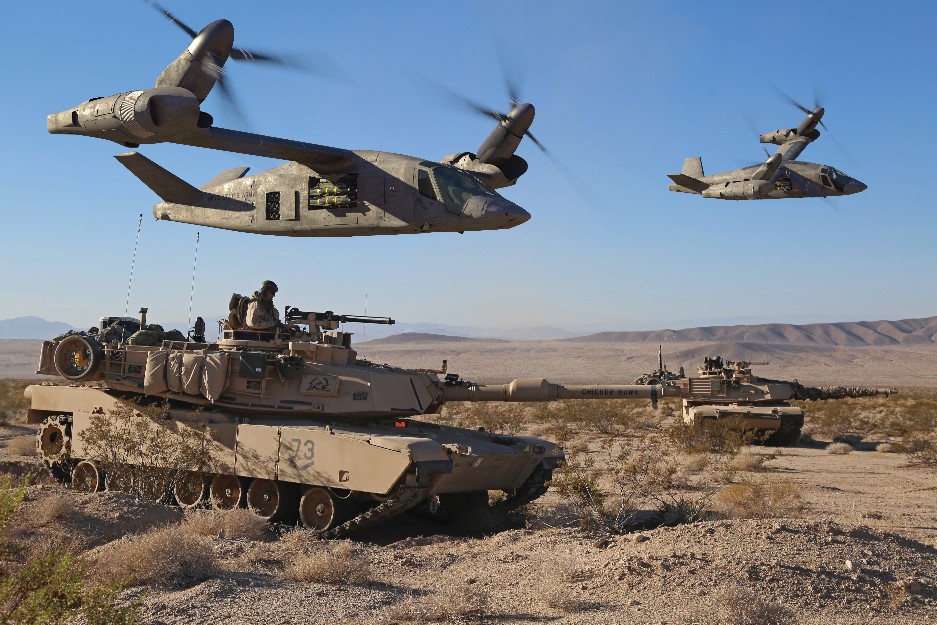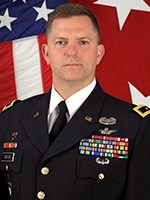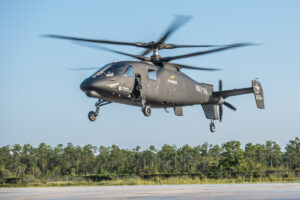ASSOCIATION OF THE US ARMY HQ: The Army wants long-range, fast-moving reconnaissance forces to scout across Eastern Europe in a future clash with Russia. Reporting directly to three-star corps commanders, these special squadrons would probably be the first units to get the revolutionary Future Armed Reconnaissance Aircraft (FARA) the service wants flying by the mid-2020s to replace conventional helicopters. It’s all part of the Army’s push, not only to revive its Cold War capabilities after a generation of guerrilla warfare, but to reinvent itself for a fast-paced, wide-ranging form of future warfare it calls Multi-Domain Operations.
“We do know that our corps lack the capability they used to have, and we know they need something back,” said Maj. Gen. William Gayler, the commander of the Army’s aviation center at Fort Rucker, Ala. “We just don’t know yet what exactly are they going to get back…. Right now, nothing is off the table.”
That caveat aside, Gayler told me and other reporters here this morning, “any person that studies it would tell you it would be advantageous for our corps to have (three things:) long-range artillery, aviation, and an intelligence collection capability.”
“The timing’s right,” Gayler said, because these new corps-level units would be created at about the same time as the new FARA rotorcraft enters service. Issuing FARA, or any new aircraft for that matter, to an existing Combat Aviation Brigade would probably take that CAB out of action for a rear as it was reequipped, reorganized, and retrained, he said. That’s something the Army can hardly afford when it has only 11 CABs and 84 percent of its aviation assets are continually committed to operations around the world.
If you issue the new aircraft to a new unit, by contrast, there’s no existing structure to revamp or ongoing operations to disrupt. (That said, the service is also studying reorganization of the CABs themselves, Gayler said, potentially customizing the currently interchangeable aviation brigades depending on what kind of division they belong to).
Besides, it’ll take years to build enough FARAs for the entire Army. The process will be a bit like someone filling a pyramid of champagne glasses. You start pouring at the top, but when the top is filled, the good stuff cascades sparkling down to the next tier.
In fact, several Army and industry officials noted at today’s aviation conference here, the Army is so huge, and technology advances so fast, that you can’t modernize the whole force at once. By the time you field a new weapon to part of the force, it already needs upgrades. You can never get the whole Army modernized to a single General Issue (G.I.) standard; you can never stop pouring in new champagne.
In this context, it’s logical to keep the combat aviation brigades working on their current missions with their current aircraft, while prioritizing the first handful of FARAs to fill the urgent gap at the corps level.
Hollow Corps
Why is the need for corps reconnaissance so urgent? The Army is trying to fill two gaps at once. The first is its painful lack of a dedicated scout aircraft since it retired its Vietnam-vintage OH-58 Kiowas without replacing them, which we’ve discussed in detail elsewhere. The second is the atrophy of the higher-level headquarters that would command a wide-ranging, fast-moving war between great powers.
For a generation, the Army has fought war at the retail level, waging counterinsurgency village by village, block by block in Afghanistan and Iraq. Guerrilla warfare is intensely local and relatively slow; long periods of patrolling, reconstruction, and patiently sipping tea with local leaders, interrupted by spasms of short-range violence. By contrast, a great power war would spread rapidly over vast distances, with unrelenting violence around the clock until one or both sides is exhausted. Russia and China in particular have invested in vast arsenals of long-range missiles and artillery rockets they can bring to bear in minutes once drones and radio direction-finding pinpoint the target.
So for counterinsurgency, starting in 2003, the Army reorganized into relatively self-sufficient combat brigades, each of which garrisoned a specific territory, while higher headquarters like divisions and corps played a supporting role. In World War II, by contrast, divisions and corps commanders directed day-to-day operations, with brigades and regiments as their playing pieces on a vast and bloody board. For a 21st century war with Russia in the open plains of eastern Europe – or for that matter a war with China in the island-dotted expanses of the Pacific, for which the Army is testing a new kind of combat unit – those higher echelons would play a leading role again, but using new and farther-ranging technologies.
That brings us back to Gayler’s three capabilities required for Army corps:
- Intelligence collection, which has become increasingly dependent on drones;
- Artillery, where traditional howitzers have been overtaken by long-range precision-guided missiles; and
- Aviation, where the Army and Marines want to replace today’s helicopters with longer-ranged and faster aircraft such as tiltrotors.
All three functions depend on the other. Aircraft need intelligence to avoid enemy anti-aircraft defenses; artillery needs intel to find targets, aircraft can gather intel; and artillery can destroy air defenses to let aircraft scout deeper and find the next set of targets for the artillery. All three functions are also operating at longer and longer ranges as technology advances, making them a natural fit for higher echelons like corps and division rather than more localized brigades.
Some military thinkers, most famously retired Col. Doug Macgregor, have argued every brigade needs its own aircraft, as elite Armored Cavalry Regiments did in the Cold War. (ACRs, not coincidentally, were elite reconnaissance forces reporting directly to the corps commander). But the Army has long argued that parceling out aircraft this way is inefficient, and it’s better to centralize expensive and specialized functions such as aviation maintenance.
Brigades need access to scout aircraft, Gayler said, but they don’t necessarily need to own them. The goal, you said, is to “give them the capability, without burdening them with the logistical requirement to sustain it.” It’s similar to how the Army will centralize cyber warriors at higher echelons – in part because they’re simply scarce, in part because legal authorities restrict their use – but tie them into frontline brigades to provide tactical support as needed.
The ultimate goal is what the military calls Multi-Domain Operations: the integration of forces from all five domains – land, sea, air, space, and cyberspace – into a single battle plan that pressures the enemy relentlessly from all sides, exploiting every possible weak point until the adversary’s defenses collapse. The Army and Air Force got pretty good at a subset of this with their AirLand Battle doctrine, which arose during the Cold War and guided two successive blitzkriegs against Iraq. But expanding this kind of coordination to all five domains, against high-tech, great-power opponents, will require new technologies, new organizations, and new concepts, and Army aviation is on the cutting edge.




























